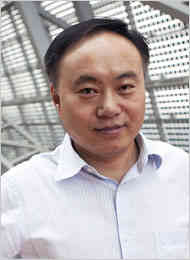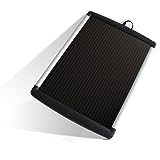
Shi Zhengrong:the Sun-KingVisiting the high technology zone in China’s eastern city of Wuxi near Shanghai, guests are impressed by the massive 6,900-sq-m solar energy panel outside the new headquarters of Suntech Power.
Visitinthe high technology zone in China’s eastern city of Wuxi near Shanghai, guests are impressed by the massive 6,900-sq-m solar energy panel outside the new headquarters of Suntech Power.
The facility’s one-megawatt solar facade is the world’s largest grid-connected, building-integrated solar system, according to Suntech, the world’s largest solar module manufacturer.
Suntech has benefited from the Chinese government’s subsidies for solar photovoltaic rooftop installations and construction of solar energy plants – known as the “Golden Sun” program.
Suntech reported $321 million in revenues for the second quarter this year, up from $315.7 million in the first quarter, according to the company’s second-quarter statement.
Suntech, listed on the New York Stock Exchange, also helped Shi Zhengrong, its founder, chairman and CEO, to become one of the country’s wealthiest people.
His picture was on the cover of the US newsmagazine Time just six years after the photovoltaic and renewable energy expert graduated from the University of New South Wales and began his new career in the country of his birth.
The Suntech story has encouraged more companies to join the solar power energy field, including Sunvim, a Zhejiang-based textile maker known for one of the country’s popular towel brands.
The government has put in place two significant subsidies for solar photovoltaic installations.
Through the “Golden Sun” program, the National Energy Administration and ministries of Finance, Science and Technology are offering to subsidize half of the construction and connection costs of on-grid solar power plants and 70 percent of the cost of off-grid installations from now until 2011. The program’s goal is to produce 500 megawatts of solar power.
An earlier plan established subsidies for rooftop demonstration projects. In addition, many local governments have solar subsidy programs of their own.
Not surprisingly, these initiatives have spurred more companies to enter the solar sector.
According to domestic statistics, more than 50 solar companies from 20 provinces – including Sichuan, Hunan, Jiangsu and Zhejiang – are constructing or expanding polysilicon production lines. The overall construction capacity has reached a potential 100,000 tons.
Zhejiang Yuhui Solar Energy Chairman Li Xianshou expressed his concerns about the oversupply situation.
“There was huge production capacity last year, but how much is qualified? Many enterprises will face the possibility of being push out,” Li said.
Still, the first half of 2008 was a profitable time for many polysilicon producers.
“During that time, the polysilicon supply fell short of demand, and sometimes buyers couldn’t get orders even if they delivered full payments first,” said a sales manager at a polysilicon company based in Zhejiang.
The sales manager said his company’s supplies would empty overnight during busy times.
In Zhejiang, the traditional textile manufacturing hub of Jiaxing, is turning itself into a polysilicon manufacturing hub.
“It requires 100 million yuan ($14.65 million) for a startup in the solar photovoltaic industry,” said Shen Fuxin, general secretary of the Zhejiang Solar Energy Industry Association.
“But many companies were still scrambling to come on board, as the industry’s average profit return could reach 20 percent or 30 percent,” Shen said.
However, the solar manufacturing industry has been hit hard since the end of last year due to a freeze in credit resulting from the global financial crisis, as well as an oversupply of solar panels that have sharply reduced prices.
The government’s new guidelines to curb the solar industry’s oversupply might push newcomers or small players out of the market, but apparently won’t affect the major players, sources said.
Yingli Energy Group, one of China’s leading solar cell manufacturers, is reporting increased sales this year.
“We saw shipments increase quickly since the middle of this year,” said a sales manager from Yingli who declined to be named.
He said the government’s crackdown on oversupply will negatively affect small companies, but added that large companies will continue to win market share because of brand reputation.Visiting the high technology zone in China’s eastern city of Wuxi near Shanghai, guests are impressed by the massive 6,900-sq-m solar energy panel outside the new headquarters of Suntech Power.
The facility’s one-megawatt solar facade is the world’s largest grid-connected, building-integrated solar system, according to Suntech, the world’s largest solar module manufacturer.
Suntech has benefited from the Chinese government’s subsidies for solar photovoltaic rooftop installations and construction of solar energy plants – known as the “Golden Sun” program. But with prices of solar panels plummeting (good news for ordinary customers), that policy is about to go into reverse.
Suntech reported $321 million in revenues for the second quarter this year, up from $315.7 million in the first quarter, according to the company’s second-quarter statement.
Suntech, listed on the New York Stock Exchange, also helped Shi Zhengrong, its founder, chairman and CEO, to become one of the country’s wealthiest people.
His picture was on the cover of the Time just six years after the photovoltaic and renewable energy expert graduated from the University of New South Wales and began his new career in the country of his birth.
The Suntech story has encouraged more companies to join the solar power energy field, including Sunvim, a Zhejiang-based textile maker known for one of the country’s popular towel brands.
The government has put in place two significant subsidies for solar photovoltaic installations.
Through the “Golden Sun” program, the National Energy Administration and ministries of Finance, Science and Technology are offering to subsidize half of the construction and connection costs of on-grid solar power plants and 70 percent of the cost of off-grid installations from now until 2011. The program’s goal is to produce 500 megawatts of solar power.
An earlier plan established subsidies for rooftop demonstration projects. In addition, many local governments have solar subsidy programs of their own.
Not surprisingly, these initiatives have spurred more companies to enter the solar sector.
According to domestic statistics, more than 50 solar companies from 20 provinces – including Sichuan, Hunan, Jiangsu and Zhejiang – are constructing or expanding polysilicon production lines. The overall construction capacity has reached a potential 100,000 tons.
Zhejiang Yuhui Solar Energy Chairman Li Xianshou expressed his concerns about the oversupply situation.
“There was huge production capacity last year, but how much is qualified? Many enterprises will face the possibility of being push out,” Li said.
Still, the first half of 2008 was a profitable time for many polysilicon producers.
“During that time, the polysilicon supply fell short of demand, and sometimes buyers couldn’t get orders even if they delivered full payments first,” said a sales manager at a polysilicon company based in Zhejiang.
The sales manager said his company’s supplies would empty overnight during busy times.
In Zhejiang, the traditional textile manufacturing hub of Jixiang, is turning itself into a polysilicon manufacturing hub.
“It requires 100 million yuan ($14.65 million) for a startup in the solar photovoltaic industry,” said Shen Fuxin, general secretary of the Zhejiang Solar Energy Industry Association.
“But many companies were still scrambling to come on board, as the industry’s average profit return could reach 20 percent or 30 percent,” Shen said.
However, the solar manufacturing industry has been hit hard since the end of last year due to a freeze in credit resulting from the global financial crisis, as well as an oversupply of solar panels that have sharply reduced prices.
The government’s new guidelines to curb the solar industry’s oversupply might push newcomers or small players out of the market, but apparently won’t affect the major players, sources said.
Yingli Energy Group, one of China’s leading solar cell manufacturers, is reporting increased sales this year.
“We saw shipments increase quickly since the middle of this year,” said a sales manager from Yingli who declined to be named.
He said the government’s crackdown on oversupply will negatively affect small companies, but added that large companies will continue to win market share because of brand reputation.






One Response
Living close to China, I hope that they continue the support past the 2011 date. Their need for energy is going to increace and the effect of their coal station does show up often in the skies here.